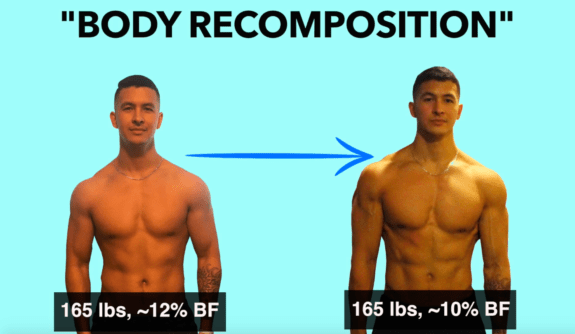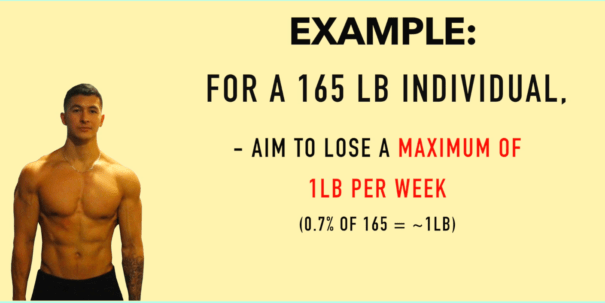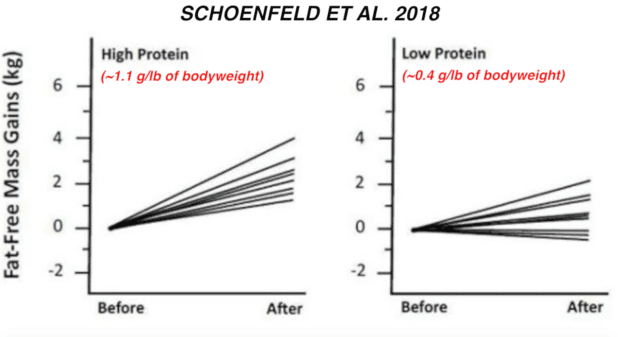Diet Plan to Drop Body Fat
Common belief has us convinced that building muscle and losing fat simultaneously, also known as body recomposition, isn't feasible for most natural lifters. You'll often hear that you're stuck with one of two options: "Either you eat at a caloric surplus in order to build muscle or eat at a deficit in order to lose fat." But based on my own experience and a review of dozens of body recomposition studies, this simply isn't the case. Building muscle and losing fat at the same time is definitely possible, it just comes with a catch. Body recomposition protocols are typically more effective if: Keep in mind that if you're a more intermediate lifter, body recomposition can still occur in some cases but at a much slower rate. And mainly only if you're at a higher body fat % and willing to perform a slow cut. Before that: if you're looking for a training program that'll guide you through, in a step-by-step manner, how to build muscle and lose fat, I've got just the thing for you. Every BWS program is designed to help you transform your physique in the most time-efficient manner. And best of all? It's all rooted in science. For more information on how BWS programs can help you to look better - FAST: Click the button below to take my analysis quiz to discover the best program for you: ↓ If you want to learn exactly how to successfully achieve a body recomposition with science-backed methods, then you need to read this article.
Body Fat Percentage

This is the method I've personally used to help me maintain (and even build) my muscle while dropping body fat despite having years of lifting experience. Although this is a slow process, it's an effective strategy to achieve a body recomposition in more trained individuals.
But regardless of which category you fall under, in order to successfully achieve a body recomposition, there are a few key points that you need to implement correctly and that's what I'll be covering in this video.
Step 1: Eat at a slight caloric deficit
In order to successfully build muscle and lose fat simultaneously, the first step Is to eat at a slight caloric deficit. Higher deficits will maximize more fat loss but will counteract muscle gain as a consequence.
Therefore, you need to set up your caloric deficit so that you're able to lose some fat while enabling muscle gain. One 2011 study by Garthe and colleagues showed that even elite trained athletes were able to gain muscle while losing fat over a 9 week period. They achieved this by performing a slow cut, meaning that they aimed to lose a maximum of 0.7% of their bodyweight per week.
Example of Body Recomposition

This means that for a 165 lb individual, they'd aim to lose a maximum of around 1 lb per week. For most people, this equates to a maximum daily caloric deficit of around 500 calories.
Simply meaning that you're eating a maximum of 500 calories below your maintenance everyday. I'd argue that the more trained you are, the smaller this deficit should be. Beginners and detrained individual
s will be able to get away with a higher deficit (e.g. 500 calories) and still achieve a body recomposition.
And keep in mind that your weight might actually stay the same (or even increase) throughout the process. This happens because you're losing fat but gaining an equal amount of muscle simultaneously.
This mainly occurs if you're a beginner or detrained and have a greater ability to build muscle while losing fat. But regardless of what your weight is doing, make sure it isn't dropping too fast and maintain your slight deficit throughout the process.
Step 2 = Maintain a high protein intake
Adequate protein intake is essential for a body recomposition in order to maintain a positive nitrogen balance despite being in a caloric deficit. This ensures that your muscles still have what they need for growth.
Generally, research shows that anything over around 0.8g/lb of bodyweight is unnecessary in terms of muscle growth and maintenance.
However, in studies where subjects were able to achieve a successful body recomposition, they were often intaking around 2.4 to even 3.4 g of protein / kg of bodyweight. This is equivalent to roughly 1g to 1.6g/lb of bodyweight.
In fact, one 2018 study by Schoenfeld and colleagues even showed that every single subject on a high protein muscle building diet of a little over 1g/lb of bodyweight gained muscle while losing a kilogram of fat. Whereas the subjects in the low protein group (~0.4g/lb of bodyweight) still lost 1 kg of fat but many of them also lost muscle with it or didn't see any muscle gain. The results can be seen in the graph below.
Schoenfeld Study

Based on this it's clear that body recomp is more likely to occur with a high protein science based diet.
However, protein intake is (and will likely always be) a grey area. Although the previous studies I mentioned found superior results with a higher protein intake over the recommended 0.8g/lb of bodyweight, the lower protein groups in these studies were all below this recommendation.
Thus, future studies need to compare a protein intake of 0.8g/lb of bodyweight with an intake above this to see if a higher intake really does promote body recomposition.
But although the exact protein intake that is optimal for a body recomposition is relatively unclear at the moment, I think the literature suggests that intaking 0.8 to 1g per pound of bodyweight and maybe even more is ideal. I'd personally suggest experimenting with it and seeing how your body responds!
Struggling to hit your daily recommended intake of protein? Don't worry. Our 3-on-1 coaching program can help. You will not only have a dietitian to customize your nutrition plan, but also a coach to focus on your training plans - plus, there's me to answer your questions every month! You'll achieve your dream physique in record-breaking time. Sounds good? Let's get started then:
Click the button below to find out more about the 3-on-1 coaching program:
↓
Step 3 = Progress in the gym
The third tip is to ensure that you're progressing in the gym. Your muscles need a stimulus to grow, and we provide that through resistance training.
As a beginner or detrained lifter, this is relatively easy to do since you're able to gain strength quickly in the gym. So stick to a solid training program and ensure that you're progressively overloading it throughout the weeks which can be done by increasing reps or the weight lifted in your exercises.
On the other hand, the more training experience you have, the harder this will be to do. But given that you're utilizing only a small deficit with adequate protein, your body still has the energy and positive nitrogen balance it needs to progress in the gym.
This has been shown in several studies on elite gymnasts, aspiring physique competitors, and football players who were already squatting over 380 lbs and benching over 280lbs when starting their body recomposition! They were all able to drop body fat while gaining some muscle and strength - meaning that body recomposition in trained individuals is definitely possible and common!
The key for more advanced individuals though is sticking to steps 1 and 2 AND properly setting up your training program in a way that allows consistent progression. This simply means that you're following a structured (possibly periodized) program, integrating deloads, and using a progression scheme that prevents you from reaching plateaus.
This is something I'll cover in more depth in a future article. For now, check out some of my science-based workouts to get an idea of what kinds of exercises you should be incorporating.
Body Recomposition Takeaways
So to sum the article up, in order to successfully achieve a body recomposition, you want to implement the following 3 steps:
- Maintain a slight caloric deficit that allows a maximum of 0.7% weight loss per week. Just keep in mind that weight loss might not occur especially in beginners/detrained individuals.
- Intake adequate protein of at least 0.8-1g per lb of bodyweight. I'd also suggest experimenting with higher intakes. This might provide additional body recomposition benefits in some individuals. And no, high protein intakes are not harmful for you.
- Stick to a solid training program that focuses on progressive overload and consistent progression.
Limitations Of Body Recomp
With that being said, I also want to mention the limitations of body recomp:
- It's clear that the closer you are to your genetic potential, the less drastic your body recomposition will be and it may not occur at all.
- The same applies for how lean you are. The leaner you are, the less likely you are to recomp since your body has less fat to utilize for energy.
- This isn't an effective strategy for hardgainers or those with a low body fat and need to put on a lot of size. In this case you should focus on lean bulking by eating at a slight surplus in order to maximize muscle and strength gains.
Despite these limitations, I'd suggest utilizing the above tips I discussed and seeing how your body responds. I've personally experienced a lot of success with it despite my years of training, and I've applied the same approach to several clients of mine with great success. The only way to find out if this will work for you is to try it out!
And for those looking for a complete step-by-step program that uses science to show you how to properly train AND eat week after week to transform your body in the most efficient and injury-free way possible, then:
Click the button below to take my analysis quiz to discover the best program for you:
↓
By the way, here's the article summed up into a YouTube video:
How to Build Muscle and Lose Fat Simultaneously (3 Science-Based Tips)
Anyways, I hope you guys enjoyed this article! Feel free to let me know if you have any questions down below. And give me a follow on Instagram , Facebook , and Youtube where I'll be posting informative content on a more regular basis. Cheers!
Source: https://builtwithscience.com/body-recomposition/
0 Response to "Diet Plan to Drop Body Fat"
Post a Comment